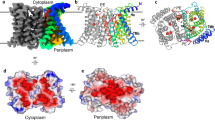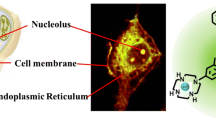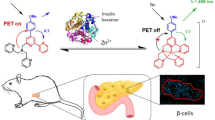p
-toluenesulfonamido-quinoline, TSQ, are potentially powerful probes of intracellular zinc chemistry; however, the structure, thermodynamics, and stoichiometry of the metal complexes, and the molecular basis of Zn(II) recognition, remain open issues. To address these, we report the first structural characterization of a Zn(II) complex of a TSQ derivative, namely 2-methyl-6-methoxy-8-p-toluenesulfonamido-quinoline (3) and describe its unusual coordination chemistry. The crystal structure of the fluorescent complex of 3 with zinc reveals a 2 : 1 stoichiometry wherein bidentate coordination of two nitrogens from each ligand gives rise to a highly distorted tetrahedral Zn(II) center. Both sulfonamido groups in the zinc complex are tilted away from zinc to make room for coordination of the amide nitrogens. Zn-O(2) and Zn-O(4) distances are essentially nonbonding (3.06 and 3.10 Å, respectively). The bond angles [N(1)-Zn-N(2) 83.5° and N(3)-Zn-N(4) 83.0°] are quite small relative to the 109° angle of an ideal tetrahedral center. This result provides an insight into the zinc-binding mode of the TSQ derivative zinquin, in which a methyl group replaces the hydrogen in the 2-position of the quinoline ring. The methyl group and sulfonamide oxygen atoms clearly hinder formation of both square planar and octahedral complexes. We also show here that the Zn(II) complex of 3 in DMSO-water (80/20 w/w) exhibits an overall binding stability (logβ 2 = 18.24 ± 0.02) similar to zinquin. Fluorescence microscopy suggests that each of these members of this family demarks a similar set of Zn(II)-enriched compartments that are common to all eukaryotic cells examined to date, and further shows that the ester function is not required for observation of these ubiquitous Zn-loaded compartments. The combined structural, thermodynamic, and physiological results provide a basis for design of other Zn(II)-specific membrane permeant probes with a range of Zn(II) affinities and photophysical properties.
Similar content being viewed by others
Author information
Authors and Affiliations
Additional information
Received: 8 May 1999 / Accepted: 15 September 1999
Rights and permissions
About this article
Cite this article
Nasir, M., Fahrni, C., Suhy, D. et al. The chemical cell biology of zinc: structure and intracellular fluorescence of a zinc-quinolinesulfonamide complex. JBIC 4, 775–783 (1999). https://doi.org/10.1007/s007750050350
Issue Date:
DOI: https://doi.org/10.1007/s007750050350




